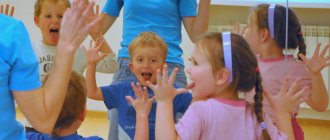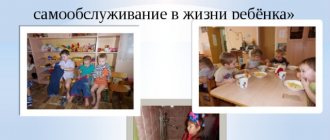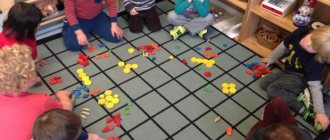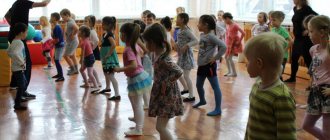Charging components
- Introductory part. First, children walk in a circle, then begin to perform simple movements while walking, for example: walking on their toes with their hands on their belts; walking on your heels with your hands behind your head; walking like a horse with high knees; walking in single file. Next - easy jogging. The introductory part ends with walking and changing lanes. Children of younger groups stop to perform basic exercises in a circle. Children of older groups can form 2 or 3 columns or ranks.
- Main part. General developmental exercises for all muscle groups. Morning exercises begin with training the shoulder girdle, then the muscles of the back and pelvis are involved. Next, exercises are performed for the legs and feet, including squats and jumps.
- Final part. Its goal is to restore breathing. The guys do breathing exercises either on the spot or while walking in a circle.
Gymnastics in the younger group
As mentioned earlier, gymnastics is performed with children in a playful way. Children can portray gnomes, a train, cyclists, flowers, mother's assistants, etc. Each exercise corresponds to a game task. For example, the exercise “Gnomes cleaning shoes” is represented by the following task:
- starting position – feet shoulder-width apart, arms along the body;
- the right leg is placed forward on the heel, the torso leans forward;
- imitation of the movement of cleaning shoes with hands;
- initial position;
- the left leg is placed forward on the heel, the torso leans forward, the movements are repeated.
During morning exercises in the younger group, the teacher must show the children the movements. If a child is not in the mood to do exercises in the morning, then there is no need to force him. Morning exercises in kindergarten should evoke only positive emotions; an individual approach is a prerequisite for the teacher. If the child is capricious and does not want to jump with the children, leave him alone, because the baby may not feel well or be upset.
Preparing to charge
Morning exercises begin with formation in a column. There is a set of exercises without sports equipment, but more often teachers give the children flags or plumes, blocks from a plastic construction set or balls, gymnastic sticks or rattles. The kids are given attributes in advance, and older preschoolers independently take turns sorting the objects from special containers. Sometimes the teacher appoints a person on duty who distributes sports equipment to his comrades.
The cubes can be laid out on the floor so that after the first part of the exercise, children stop near them to perform a set of basic exercises. Before use, the teacher must check the technical condition of the items used so that they are completely safe for children.
Where does charging take place?
In the warm season, morning exercises are carried out outside, on the territory of the group. With older children, jogging is sometimes organized around the kindergarten building or in a designated area. During the cold season, morning exercises are performed in a group or in a gym. If the kindergarten does not have a specially designated room for physical education, then time is allocated for exercise in the assembly hall. Twice a week, many preschool institutions organize morning exercises with musical accompaniment. Rhythmic activities develop a sense of tact and an ear for music.
Preparatory group for school
The set of exercises for children 6–7 years old does not differ much from the previous age group. The teacher already requires clarity and excellent quality of exercises from children. The guys must not only perform the movements, but also know the starting position and intermediate positions. The muscles should feel tense.
Much attention is paid to posture and strengthening the back muscles, because the children will soon go to school and will spend a lot of time at school desks and preparing homework. To avoid curvature of the spine, you need to have strong and developed back muscles.
Children's morning exercises provide a great mood and give a charge of vigor for the whole day, help to liberate shy and indecisive children, and discipline spoiled and overexcited children. During morning exercises, children calm down faster after saying goodbye to their parents and tune in to a certain kindergarten routine.
Charging in the middle group
Children 4-5 years old are already well acquainted with the principle of performing exercises. The teacher’s attention is focused on the quality and correctness of the movements: clarity and rhythm are maintained, the child should not lag behind the general rhythm and be able to perform the complex efficiently. Children in the middle group do not learn exercises during exercise. The teacher shows how to perform a particular exercise, and the children repeat the movements after the teacher.
During the gymnastics, the teacher can make comments aimed at the correct position of the legs or back; special attention is paid to breathing during the lesson. Children should do the exercises at the same time, guided by counting.
The introductory part includes jumps and side gallop. The motor density of charging should be high, since a short period of time is allotted for it, and you need to have time to complete all the exercises several times.
Duration of charging in each age group
Depending on the age of the children, both the duration of the exercise and the number of repetitions of each type of exercise increase. If in the first junior (nursery) group the exercise takes 4–5 minutes, then in the second junior group the duration is 5–6 minutes. Exercises are selected 3-4 types, each of which is repeated 4-5 times. Exercises are given to kids in a playful way. The guys imitate the movements of animals and birds.
Morning exercises in the middle group last 6-8 minutes, and the number of exercises increases and reaches 5. Children repeat each 5-6 times.
In the senior group of kindergarten, exercise consists of 6 exercises, each repeated 6 times. The duration of the complex takes 8-10 minutes. Older children in the preparatory group study for up to 12 minutes. The exercises are more complex and repeated 8-10 times. The complex itself is also expanding: the number of exercises is 6-8.








